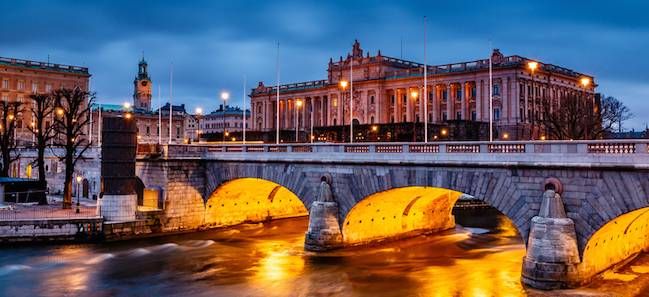
Literary Tourism: Stockholm
Stockholm is the capital of Sweden and home to a rich literary life rooted in history which, at the same time, looks towards the future. With its one million inhabitants, Stockholm is Sweden’s largest city. The center of the city is located on a group of closely situated islands, and the extensive public transport system makes it easy to get around.
The Nobel Prize in Literature
Arguably the most famous literary prize in the world, the Nobel Prize in Literature is awarded every year on the tenth of December at the Nobel Prize ceremony. The Nobel Prize ceremony has taken place at the Stockholm Concert Hall ever since the hall first opened in 1926. The Stockholm Concert Hall offers guided tours in English, showing the building’s grand foyers as well as the main hall, where the Nobel Prize ceremony takes place. After a visit to the Stockholm Concert Hall, the square just outside, Hötorget, is well worth exploring with its lively street market. Underground, there is an extensive food market and delicatessen.
The Nobel Prize banquet takes place at Stockholm City Hall. Stockholm City Hall was built in 1923 and has hosted the Nobel banquet ever since. Stockholm City Hall is a functioning office building for the City of Stockholm and is only partially accessible to the public. Guided tours of the Blue Hall, where the banquet takes place, and the Golden Hall, where the after-party dance takes place, are available all year round.
The Strindberg Museum
August Strindberg (1849–1912) is one of Sweden’s most famous and controversial authors. Known around the world primarily as a playwright, Strindberg has been credited with inventing the chamber play (e.g. Miss Julie), a dramatic genre later developed for cinema by Ingmar Bergman. Strindberg also wrote several novels. One of them—Inferno—ended up having great influence on Franz Kafka, as it tells the story of Strindberg’s own battles with insanity. The Strindberg Museum is located in the center of Stockholm, which makes it easy to get to, but the opening hours are limited. Located a short subway ride from the museum is a place called Mosebacke. Mosebacke offers a splendid view of the city, described by Strindberg in 1879 in the opening paragraph of his novel The Red Room.
The Millennium Tour
For fans of Stieg Larsson’s Millennium trilogy, Stockholm’s City Museum offers The Millennium Tour, which is a guided tour in English that traces the footsteps of Lisbeth Salander and Mikael Blomqvist. The tour takes approximately two hours. It is possible to take The Millennium Tour without a guide. Maps are for sale at the museum gift shop.
Den Gyldene Freden
Den Gyldene Freden has been serving food and drink to the public since 1722. In English, the restaurant’s name translates to The Golden Peace and refers to the peace treaty between Sweden and Russia signed in 1721. Den Gyldene Freden is a restaurant with deep roots in Swedish literature and music. For example, Sweden’s most prominent bard Carl Michael Bellman (1740–1795) ate and drank (mostly drank) here, and troubadour Evert Taube (1890–1976) still has his regular table set for him. Because of careful renovations throughout the centuries, the restaurant looks the same as when it opened in the early eighteenth century.
____________________
Want more bookish goodness, news, posts about special book deals, and the occasional puppy reading pic? Follow us on Facebook:















